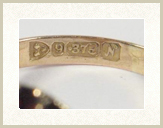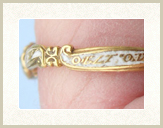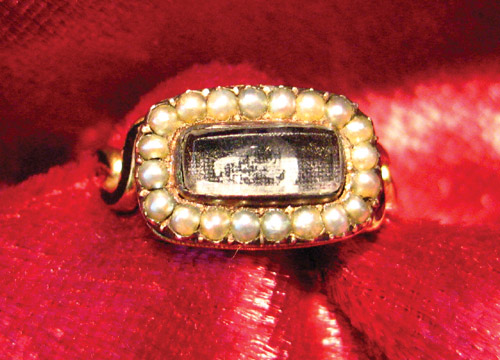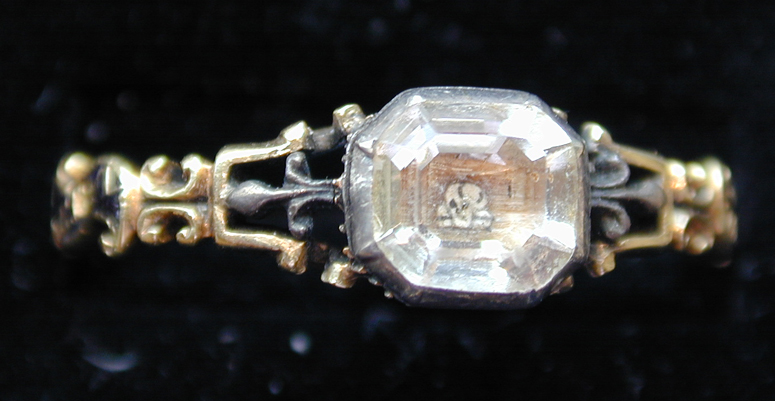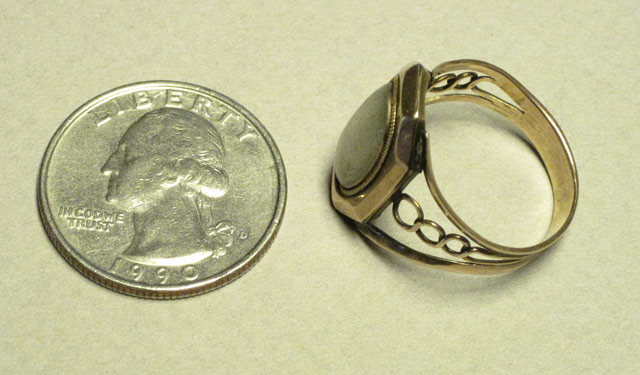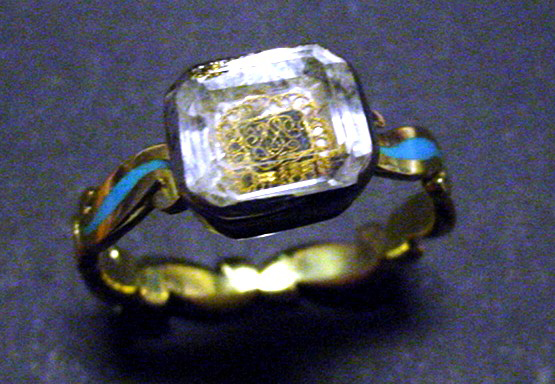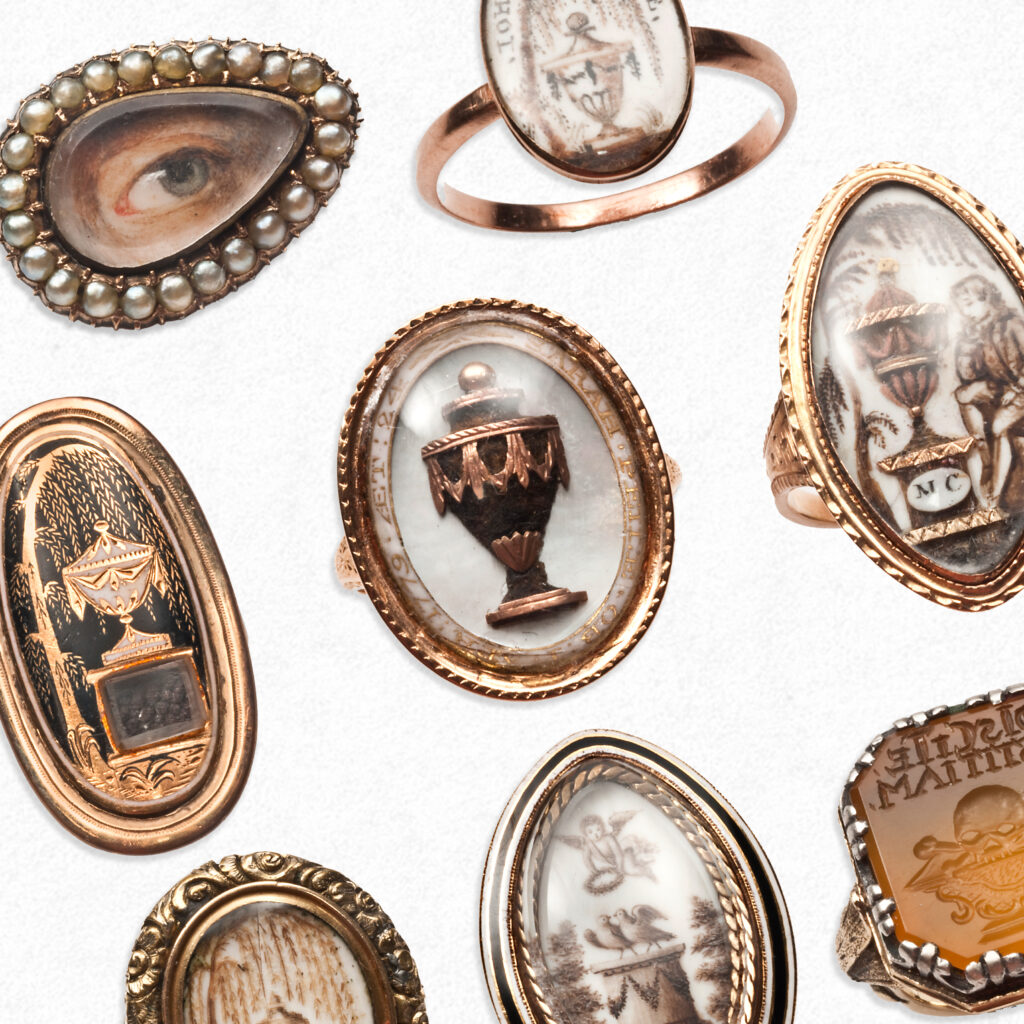A Mourning Tour: An Identification Guide to Mourning and Sentimental Jewels
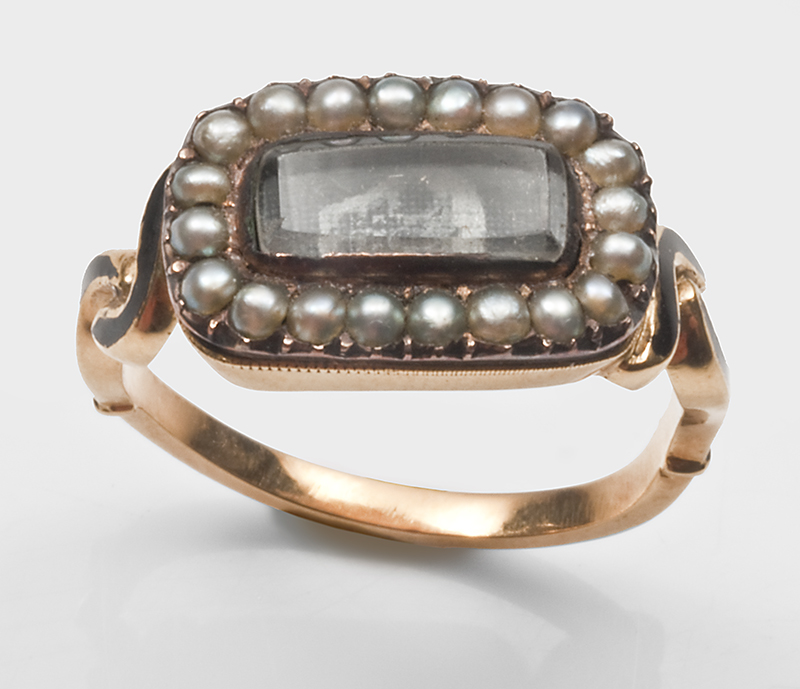
There’s been a lot of discussion about the limits of what a fake or a forgery is over at the Art of Mourning Facebook Group and I thought I’d open up the floor to a little discussion (feel free to join in over at the group) and add a bit of commentary.
I’ve mentioned before that I began Art of Mourning as a tool to put down as much knowledge as possible before my loved ones eventually require a mourning ring made up of myself and to dispel as much fiction surrounding a piece for the new collector or the seller who isn’t completely sure of what they have in their hands.
Once upon a time, an antique dealer once said to me that the best sellers in the world are the ones that listen to the collector and absorb the knowledge, as opposed to being seemingly knowledgeable over a large area of collectables. The collector has the passion, the collector is the boffin who spends their life in pursuit of a singular item.
However, it’s no secret that there are items out there which are reproduced for the singular purpose of monetary gain and to obfuscate the collector. These exist and are sold under the pretence of being something they are not, something which does not represent the past but is clearly being sold as a piece from the past.
For those who have been collecting antiques or are very knowledgeable about them, there’s an understanding that these items have always existed and there’s not much one can do apart from learning more about the subject and being deceived. Then, there is the new collector or person who may be fooled by the piece, thinking it too good to be true or a genuine item. Here is where there is a grey area surrounding whether or not to directly engage with them and identify that the piece is an obvious forgery, or to turn the other cheek.
Contemporary Jewels
Contemporary Piece Matching
Always match a piece that you are looking at to another. Be it from books, a collection, museum or even this website, find a reference point of the piece in order to properly justify what it is. If a piece does not match with others that it is trying to emulate, then one must wonder why and see if it is a later piece or an oddity for its time.
Symbolism
Conflicting symbolism is a big problem. It is also hard to identify, as different cultures used symbolism at earlier periods than others. French pieces may have a higher quality and propensity for delicate symbolism and in the 18th century mix popular 19th century motifs with contemporary ones. People who commission pieces may have put in antique or unfashionable symbolism, so judging by symbolism alone can be difficult. However, when a piece does have obvious conflicting symbolism, these can be easy to spot. Usually memento-mori replicas can be spotted because of overly detailed skulls.
As can be seen in this article, there are many reasons for a piece to not conform to a particular style or period from which it came. However, this does not necessarily mean it is a deliberate forgery, and could instead be the result of a piece being handed down in one family and added to throughout the years, or the updating of pieces to reflect new fashions and sensibilities. Having said that, the collector must always keep a questioning mind when examining pieces and ensure that the story to be read in a piece is an authentic one. This means examining a piece’s construction, any marks present and any signs of a marriage of two pieces. A good knowledge of the different art styles and periods relating to sentimental and mourning jewellery also aids this process. Armed with this knowledge, the collector will be able to discern quality pieces from those which are of lesser quality.
Plastic, Odd Material and Repairs
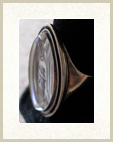
Use of plastic or materials that are not developed in the contemporary time frame of a piece are obvious things to look out for. There is quite a culture of ‘doctoring’ pieces by removing scratched or worn glass compartments and replacing them with plastic (or glass). Remember to test if you are unsure, but usually unnecessary bevelling and flat pieces of glass or plastic may take the place of an elegant Neo-Classical curve to a brooch, pendant or ring.
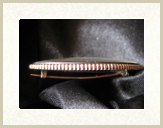
Enamel work is also a popular aspect of repairing. Spotted enamel work (mismatching) or a piece looking just far too clean for its age raise many questions. Be careful with anything that seems too perfect and remember that most pieces have lived many hundreds of years.
Also, materials often dictate their times; some older materials were in fashion at later dates (such as silver and marcasite).
Different Metals
Metal mismatching in jewellery is used for effect or not at all. When a piece, such as a pendant and chatelaine combination, does not match, or a ring has an odd shank and bezel, one must wonder why these pieces are mismatched with their metal work. Often they are marriages of pieces and there is a culture of constructing greater pieces from lesser in order to gain more money for them.
Solder Marks
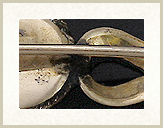
Solder marks are a good sign of repair work or change in a piece. The biggest problem with earlier pieces is that they have been converted from one type to another, such as brooch to ring. Solder marks are good ways of spotting changes to pieces and one can often find a good continuity to the life of a piece if studied correctly. These may be as small as the change of a brooch clasp or as large as the conversion of a ring.
Hallmarks
Hallmarking is the best standard to identify a piece, but unfortunately (although mostly illegal), jewellers are known to falsely stamp pieces. Hallmarking is the process of stamping precious metals, as they are intended to be stamped by the Assay Office to guarantee purity of the piece.
When collecting, it is necessary to bring a hallmarking book along to assist with the identification of pieces, as the listings are so vast that there is no way to fully comprehend each and every stamp.
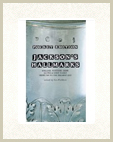
Recommended is Jackson’s Hallmarks, and excellent and conveniently sized reference book for transport and identification. Hallmarks are the most honest way to find the maker and year a piece was created, with both gold and silver.
Earlier pieces do not have hallmarks with which to guide the collector, but 19th century pieces are easy to identify. Be sure hallmarks match and that they are honest to the piece. Many pieces have been falsely stamped in recent years to give a piece provenance, but can often be false. Check the marks have consistent wear with the piece and that the year / maker and any tax or import marks match.
Resources:
> Online Encyclopedia of Silver Marks, Hallmarks and Maker’s Marks
Gold Content
Gold and silver were marked with the same standard until 1798, when the introduction of 18 carat gold required standard gold marking. However, 22 carat was stamped with the same marks as sterling silver until 1844. The demand for cheaper gold watch cases in America saw 9, 12 and 15 carat added to the marks in 1854. This means that by 1854, there were marks for 9, 12, 15, 18 and 22 carat. 14 carat was introduced in 1932, replacing 15 and 12 carat, creating the current four standards: 9, 14, 18 and 22.
Gold marking is a difficult standard to follow, as (pre 1906) some countries did not stamp and quite often, pieces are unstamped regardless of territory. Most commonly, the US used 10K, 14K and 18K marks; many memorial pieces were 9 carat, given their popularity and ubiquitous nature post 1854. In Europe, marks are generally for the fineness of the metal and the following carat indicators are not exactly accurate representations of the numbers: 750 / 18 carat, 375 / 9 carat and 625 / 15 carat.
Pinchbeck, a form of brass (an alloy of copper and zinc) is a very popular material used in mourning pieces from the middle of the 19th century. Be sure that when buying a piece it is not for its gold content in these cases. Often, the clasps are marked, with other fittings pinchbeck.
How to Spot a Forgery
There are many tell-tale signs of a forgery. By “forgery”, I mean a piece that was constructed in order to dupe the collector into buying what they perceive to be an authentic piece. However, by gaining knowledge (through this website and other sources) about styles, art and fashion that are relevant to mourning and sentimental history, the collector will soon be able to analyse and judge a wide variety of pieces.
While a general knowledge of different styles and periods is necessary before analysing pieces, the construction of jewellery is the area where a true forgery may be spotted, or at least its provenance called into doubt.
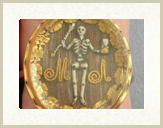
Firstly, let’s look at the terminology that may be used. Memento mori is one of the most commonly used terms that can make a seller quite a lot of money very fast. These early styles of mourning jewellery command a hefty premium due to their symbolism. Why is this? The ever increasing popularity of the skull and crossbones, the skeleton, cherubs, scythe, all these timeless representations of death and memorials will always be marketable and it doesn’t take much to convince someone to buy them. Simply putting the terms memento mori and mourning in the same sentence will pique the curiosity of even the non-collector.
Let’s look at the history of it. Memento mori did not start off as strictly mourning, it was a statement of living and final judgement. There was a philosophy behind it, but as the mourning industry took flight and greater social mobility allowed mourning paraphernalia, the marriage of these funeralia symbols and fashion was only inevitable.

So on the whole of it, we have two different kinds of memento mori jewellery moving from the 1400s to the 1600s, earlier pieces (are they the prototype or a different thing altogether?) may be considered what is pure. But then again, that would invalidate what is popularly considered memento mori jewellery during the 17th and 18th centuries!
The skull and crossbones motif continued even when it was out of popular fashion in jewellery and is considered an anachronism. Pieces from 1760 onward (after the advent of the neoclassical movement) are still prevalent, as this was and is considered a standard funerary motif.
Then there are the various memento mori revivals, which try to re-spark the philosophy of the earlier period. Revivals and reproductions of 16th and 17th jewellery were also quite popular across Europe in the 19th century and it’s quite easy to be fooled by some pieces. Combine this with the various fraternal and ‘secret’ organisations of the period that used the skull as a motif and you’ve got a great deal of items that can cause a lot of head-scratching and critique.
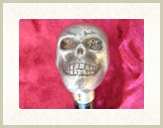
But, are these pieces all considered fake? It’s the terminology of the modern seller than can cause that kind of reaction. Lack of knowledge by a seller can turn a very respectable 19th century piece into something that may irritate the collector. The genuine forgery is the one that tries to copy a piece or mimic a style exactly under the pretence of subterfuge and deceit.
So, when you’re looking at a piece, be sure to critique it for its merits and when it doubt, question everything!
Conflicting Styles
If a piece has conflicting styles, such as an enamelled skull with an art deco shank or if a piece were a crystal in silver with marcasite, one must consider that there is a degree of mystery about it. On the more positive side, the real odd piece are full of questions and can be very rewarding to research. On the negative side, they are more often than not forgeries with inept construction. Conflicting style is more prevalent in modern pieces where the aim is to reap the rewards of the forgery. 19th century conflicts of style in forgeries are harder to discern, as they may have an honest pedigree with conflicting styles being part of a piece’s aesthetic.
Of note is this piece to the left. Now, the obvious question must be asked; is it genuine? Upon looking at the piece, even the untrained eye can spot the conflicting colours of the metal from the band to the bezel. This should immediately raise alarm bells for the collector, as it is not natural for a piece that it is trying to emulate. How so?
The band itself is using Rococo-styled flourishes, a method that would try and pin this style of piece (on the other side is a crystal with gold cypher initials which looks reasonably genuine.) S0, the seller has tried to put the piece into the paradigm of the early to mid 18th century, however the execution of the band is so naively done that it completely detracts from the reasonably genuine nature of the bezel.
Compare this with the piece to the right. The delicate gold work and the attention to the Rococo stylings is what one should look for in such a style, so for a collector, one must wonder when the Rococo band was added to the first piece. Would you consider it to be a 19th century addition, and if so, does that make it worthwhile in your eyes? Or do you think that jewellers of the 19th century would treat their subjects with a little more care, having been closer in years to the reality of the art style and using less mass-produced methods of construction?
The one reality is that it is a marriage of styles and any conflicts in a piece must be addressed before you buy.
Memento Mori?
The skull in depiction is a good way of understanding whether or not a mourning jewel is all it claims to be. As a collector, one has to be careful that there is no room for error when buying a piece, this is often overlooked, as many pieces can interest just due to their beauty and not their fact.
With this particular piece, one must make two assumptions; the skull is rendered contemporary for its time, but not as part of its original construction or that it is a much later addition to deceive or promote financial gain.
This is a difficult spot for the collector. Upon first examination, the ring looks remarkably correct in its style. The skull is an obvious anachronism, for it to be part of mainstream fashion when the ring is estimated to be constructed would make it an anomaly. However, the rest of the ring, with its black enamel shoulders and 1st quarter 19th century rectangular hair memento are seemingly correct.
Hence it comes down to the style of the skull being the only things we can take from it. Skull design in mourning jewels can be identified easily enough through matching detail with mainstream art and contemporary pieces. In this case, the skull is simply rendered, which does conform with earlier skulls, but isn’t definitive.
Highly detailed skulls, that you may see on modern rings would automatically default this piece to be a poor addition, but if this is modern or not can’t be discounted.
Perhaps one should question the taste in adding a skull to the remnants of a loved one, when this is the last element of the person that is left, especially in a time when the memento mori motifs were out of fashion.
Regardless, it is the curiosity in jewellery that makes it fun to discover. Each tells a tale, each resonates with personal history.
Art Revivals
The different styles of jewellery, be they Baroque, Gothic, Rococo or Neoclassical, all experienced periods of revival after they were first created, or were reproduced continuously since their inception. Of the most popular styles to be found in mourning and sentimental jewels, Gothic and Neo-Classical are the easiest to spot.
With mourning jewellery being a rather modern invention (at least for the purposes of this website – post 16th century), they were original for their time and there is no trouble in matching a Gothic or Neo-Classical ring to its respective age. For the novice collector, these are good areas to begin the accumulation of knowledge.
These styles were not reproduced at a later date; therefore, spotting forgeries of these pieces can be very easy.
At the very least, if a piece is questionable, there is a safe basis for judging what it is.
The more prominent the art style and its effect on jewellery, the more simple it is to evaluate. However, Baroque- and Rococo-style pieces are more difficult to judge for two main reasons: their replication will bring in greater money; and these periods had Victorian revivals.
While the 19th century saw a clash of revival styles and flourishes, Rococo styles were among the most popular. To a collector, however, the revival pieces will be obvious.
Pure Rococo and Barque pieces are very different from anything produced in the 19th century, which used earlier flourishes to add to different jewellery. The original pieces are pure and ornate to their nature.
It is the periods in between the popular revival periods that are harder to define. Pieces from the early 19th century throughout the Regency era are embellished with geometric lines, oval and rectangular shapes, use stones for symbolism and highlight a completely new way of constructing pieces that can almost seem more mature than more later Victorian pieces.
The Gothic Revival style, which grew in prominence and dominated jewellery design from c.1820-40 is a very important area for jewellery collectors to understand. It was a reaction to the opulence of the Neoclassical era and involved instilling a value system through design to return to simplicity and piety. The following articles are essential reading:
1850-1880 can also be difficult to be exact with, as each year has its individual style. Following the 1860s, memorial jewellery became less prevalent, and styles lingered, handed down, and often no modern alternative was created. The Victorian Rococo flourishes gave way to more rigid symbolism and became smaller and more personal.
Dating pieces is made easier with experience. Mistakes are easy to make with the evaluation of pieces in interim periods, especially without the rapid change of fashion seen in the 18th and early 19th centuries. Identification of a piece is not a sign of forgery, of course. It is during these revival periods, when antique sensibilities are reused, that the line begins to blur on what is or is not original.
The Neoclassical period is one that had a very similar revival period in the early 20th century. Due to the Romantic movement which spurred on the allegorical depictions of the Neoclassical period post c.1765, the same styles became popular again c.1901. Many of the miniature portraits and larger setting styles were copied in the 20th century to emulate the style.
There were revivals of memento-mori symbolism (two notable times and throughout the century) that can fool people into mistaking the provenance of a piece. The problem with memento-mori symbolism is that the symbols are timeless. The skull and crossbones have been used for various reasons throughout history, be it from a personal standpoint, a warning, a status symbol of the 16th and 17th centuries or to represent a society. It is often hard to identify the use of the skull in these instances: in the early 19th century, a great deal of skull symbolism was used in jewellery, which was then mixed with 19th century symbolism.
Skulls were painted on top of rings; this style culminated around the middle of the century. By the 1870s, there was another revival of the symbolism in jewellery (especially prevalent in fashionable gentlemen’s accessories). When a skull is used in jewellery throughout this period, one must identify its origins. Was it a symbol for a fraternal group? Stylistically speaking, they are usually in conjunction with the fashionable style of the time, so dating is rarely an issue; however, much concern has been given to some pieces being direct forgeries.
In order to determine if these pieces are forgeries, one first needs to think of how these pieces were developed at the time of their construction. Were they used in a revival period? Were they a symbol of a society and not memorial or sentimental at all? Was it a personal matter of the individual who commissioned it in order to reflect mortality? The pieces that can be identified are honest to their nature.
Were there complete 19th century reproductions of 16th-18th century pieces? Of course, the development of the exact forgery is not a new concept: as it happens now, it happened then. But whereas now the culture of the collector has developed, 19th century reproductions would be based upon historically important or opulent pieces that could generate a heavy price or be fashionably desirable. The point of replicating a small, personal and unfashionable mourning piece would not be worth the price of the gold or effort to do it at the time.
Marriages provide the most common identification problems with jewellery. Many 16th and 17th century pieces were added to with 19th century embellishments, but more often than not, the central jewel is consistent. This is across the board with jewellery and not simply relegated to mourning or sentimental pieces. A piece may be added to in order to be worn with current fashion or in order to enhance its sentimentality to the wearer, and often these additions do not detract from the price, but add another level of mystery to a piece.
Mourning jewellery is unique in that an entire family can be held inside a ring or bracelet. A piece constructed in 1780 can have a lifespan of 100 years and be dated in 1870; this is not unusual. As pieces pass through the hands of family members, they are added to, hair mementos may be taken out and replaced, new inscriptions added on the back.
Identifying these pieces can be very difficult and require the collector to make a leap of faith in understanding the history of the piece. They are also difficult for dealers to part with, as many people may assume that they are forgeries.




